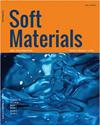Preparation and properties of silver-loaded PVA/CS/Gel hydrogel wound dressing
IF 1.4
4区 材料科学
Q4 MATERIALS SCIENCE, MULTIDISCIPLINARY
引用次数: 1
Abstract
ABSTRACT Wound dressings have been widely studied because they can temporarily protect and promote wound healing instead of damaged skin. In this paper, silver nanoparticles (AgNPs) were prepared by in situ reduction of gelatin (Gel). Then, AgNPs, chitosan (CS) and PVA were mixed to prepare silver-loaded PVA/CS/Gel hydrogel dressing through freeze-thaw and sodium citrate crosslinking. The properties of AgNPs and hydrogel dressing were evaluated. The results show that the particle size of the AgNPs successfully reduced by Gel is small and uniform. The silver-loaded PVA/CS/Gel hydrogel dressing has a homogeneous mesh structure with good moisture absorption and retention. It can maintain a moist wound environment while absorbing enough wound exudate. The excellent and stable mechanical properties of the hydrogel enable it to avoid external mechanical damage. In addition, the hydrogel shows effective antibacterial properties against both Staphylococcus aureus and Escherichia coli, and has good biocompatibility and no cytotoxicity.载银PVA/CS/Gel水凝胶创面敷料的制备及性能研究
摘要伤口敷料因其能暂时保护和促进伤口愈合而非损伤皮肤,因此得到了广泛的研究。本文采用明胶(凝胶)原位还原法制备了银纳米粒子。然后,将AgNPs、壳聚糖(CS)和PVA混合,通过冻融和柠檬酸钠交联制备负载银的PVA/CS/Gel水凝胶敷料。对AgNPs和水凝胶敷料的性能进行了评价。结果表明,凝胶成功还原的AgNPs颗粒尺寸小且均匀。负载银的PVA/CS/Gel水凝胶敷料具有均匀的网状结构,具有良好的吸湿性和保水性。它可以在吸收足够的伤口渗出液的同时保持湿润的伤口环境。水凝胶优异稳定的机械性能使其能够避免外部机械损伤。此外,该水凝胶对金黄色葡萄球菌和大肠杆菌均表现出有效的抗菌性能,具有良好的生物相容性和无细胞毒性。
本文章由计算机程序翻译,如有差异,请以英文原文为准。
求助全文
约1分钟内获得全文
求助全文
来源期刊

Soft Materials
工程技术-材料科学:综合
CiteScore
2.90
自引率
0.00%
发文量
21
审稿时长
2.2 months
期刊介绍:
Providing a common forum for all soft matter scientists, Soft Materials covers theory, simulation, and experimental research in this rapidly expanding and interdisciplinary field. As soft materials are often at the heart of modern technologies, soft matter science has implications and applications in many areas ranging from biology to engineering.
Unlike many journals which focus primarily on individual classes of materials or particular applications, Soft Materials draw on all physical, chemical, materials science, and biological aspects of soft matter. Featured topics include polymers, biomacromolecules, colloids, membranes, Langmuir-Blodgett films, liquid crystals, granular matter, soft interfaces, complex fluids, surfactants, gels, nanomaterials, self-organization, supramolecular science, molecular recognition, soft glasses, amphiphiles, foams, and active matter.
Truly international in scope, Soft Materials contains original research, invited reviews, in-depth technical tutorials, and book reviews.
 求助内容:
求助内容: 应助结果提醒方式:
应助结果提醒方式:


